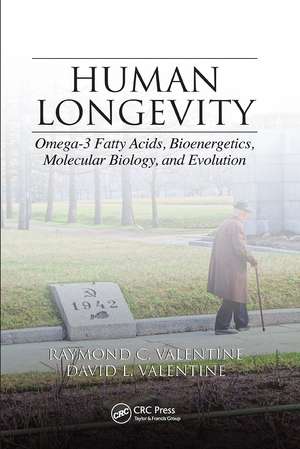Human Longevity: Omega-3 Fatty Acids, Bioenergetics, Molecular Biology, and Evolution
Autor Raymond C. Valentine, David L. Valentineen Limba Engleză Paperback – 14 oct 2024
Human cells are protected from the ravages of aging by a battery of defensive systems including some novel mechanisms against membrane oxidation introduced in this book. This concept is consistent with recent discoveries showing that mitochondria-targeted antioxidants prevent Huntington’s disease, Parkinson’s disease, and traumatic brain disease in animal models of neurodegeneration.
This book explores a unified theory of aging based on bioenergetics. It covers a variety of topics including an introduction to the science of human aging, the Darwinian selection of membranes enabling longevity, a revised mitochondrial membrane hypothesis of aging, and various mechanisms that protect human mitochondrial membranes, thereby enabling longevity.
Preț: 312.77 lei
Preț vechi: 349.28 lei
-10% Nou
Puncte Express: 469
Preț estimativ în valută:
59.85€ • 63.100$ • 49.90£
59.85€ • 63.100$ • 49.90£
Carte tipărită la comandă
Livrare economică 18 aprilie-02 mai
Preluare comenzi: 021 569.72.76
Specificații
ISBN-13: 9781032924786
ISBN-10: 1032924780
Pagini: 254
Ilustrații: 57
Dimensiuni: 156 x 234 mm
Greutate: 0.47 kg
Ediția:1
Editura: CRC Press
Colecția CRC Press
Locul publicării:Boca Raton, United States
ISBN-10: 1032924780
Pagini: 254
Ilustrații: 57
Dimensiuni: 156 x 234 mm
Greutate: 0.47 kg
Ediția:1
Editura: CRC Press
Colecția CRC Press
Locul publicării:Boca Raton, United States
Public țintă
AcademicCuprins
Introduction to the Science of Human Aging. Darwinian Selection of Membranes Enabling Longevity. Revised Mitochondrial Membrane Hypothesis of Aging. Many Mechanisms Have Evolved to Protect Human Mitochondrial Membranes, Enabling Longevity.
Notă biografică
Raymond C. Valentine is currently professor emeritus at the University of California, Davis and visiting scholar in the Marine Science Institute at the University of California, Santa Barbara. He was also the scientific founder of Calgene, Inc. (Davis, California), now a campus of Monsanto, Inc. The author’s scientific interests involve the use of reductionism to address problems of fundamental scientific and societal importance, such as agricultural productivity and aging. Some of his scientific accomplishments include the discovery of ferredoxin, the identification and naming of the nitrogen fixation (nif) genes, and the development of Roundup® resistance in crops. He holds BS and PhD degrees from the University of Illinois at Urbana-Champaign.
David L. Valentine is currently a professor of earth science with affiliations in ecology, evolution, and marine biology, as well as the Marine Science Institute, at the University of California, Santa Barbara. The author’s scientific interests involve the use of a systems-based approach to investigate the interaction between microbes and the earth, particularly in the subsurface and oceanic realms. He is best known for his research on the biogeochemistry of methane and other hydrocarbons, his works on archaeal metabolism and ecology, and his scientific work on the Deepwater Horizon oil spill. DLV holds BS and MS degrees from the University of California at San Diego and MS and PhD degrees from the University of California at Irvine.
David L. Valentine is currently a professor of earth science with affiliations in ecology, evolution, and marine biology, as well as the Marine Science Institute, at the University of California, Santa Barbara. The author’s scientific interests involve the use of a systems-based approach to investigate the interaction between microbes and the earth, particularly in the subsurface and oceanic realms. He is best known for his research on the biogeochemistry of methane and other hydrocarbons, his works on archaeal metabolism and ecology, and his scientific work on the Deepwater Horizon oil spill. DLV holds BS and MS degrees from the University of California at San Diego and MS and PhD degrees from the University of California at Irvine.
Descriere
Human cells are protected from the ravages of aging by defensive systems including novel mechanisms against membrane oxidation introduced in this book. The book proposes a unified concept in which aging cells faced with declining energy production by mitochondria and the relatively high cost of protecting membranes against oxidation are triggere
